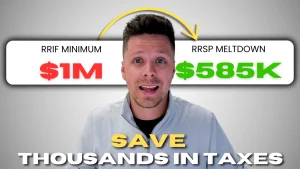[vc_row][vc_column][vc_video link=”https://youtu.be/gJWERBrGmAQ” css=”.vc_custom_1673040534150{padding-top: 20px !important;padding-bottom: 20px !important;}”][/vc_column][/vc_row][vc_row][vc_column][vc_column_text]As we approach the end of the year, there are a few tax planning strategies that you should consider before the year is out. Let’s look at if it makes sense to make an extra RRSP withdrawal before the end of the year.
Tax Planning Strategy #1: RRSP/RRIF Withdrawal
One of the major drawbacks of owning an RRSP or RRIF is the potential tax bomb it creates.
To understand the tax bomb, let’s first look at the combined Manitoba and Federal Tax Rates.
Ron makes $110,000 annually, putting him in the 43.4% tax bracket. A common misconception is that Ron must pay 43.4% tax on all his income. That is not the case. Ron will only pay tax at 43.4% on his income from $100,392 to $110,000. He will pay the corresponding rates in each bracket on the rest of his income. When we factor in these brackets, Ron’s average tax rate is only 29.15%
The Tax Bomb
Jim and Val are retired, and each makes $60,000 per year. This puts them in the 33.25% tax bracket. They each have $500,000 in their RRSPs, and when either Jim or Val passes away, they can roll over their RRSP to their spouse tax-free.
Jim passes away, and his $500K in RRSPs transfers to Val’s RRSP tax-free. At this point, Val’s RRSP is worth $1,000,000. The downside of an RRSP or RRIF is that everything in the RRSP becomes taxable upon the second spouse’s death.
If Val were to pass away with $1,000,000 in her RRSP, it would all be taxable in one year, and her estate would end up paying over 50% tax on a large portion of it.
Another common misconception is that Val could name her kids as beneficiaries of the RRSP to avoid paying the taxes. Unfortunately, this won’t work either as the estate will still have to pay the tax bill.
Wouldn’t it be great if you didn’t have to pay tax at over 50%? Thankfully you can!
Extra RRSP withdrawal
If Jim and Val each withdrew an extra $14,000 from their RRSPs, their incomes would increase from $60,000 to $74,000. A withdrawal of this size would keep them both in the 33.25% tax bracket today.
The advantage of this additional withdrawal is that it allows them to withdraw funds from their RRSP at 33.25% rather than potentially paying over 50% in the future. They can use these “extra” funds to top up their Tax-Free Savings Account or to invest in a joint non-registered account that will be more tax-efficient in the long run.
Summary
To summarize, if you have a large amount of savings in registered accounts such as an RRSP or a RRIF, it could make sense to make additional withdrawals from those accounts (even if you don’t need the money) today to pay tax while you are in a lower tax bracket.
To read more about the RRSP Tax Bomb see the articles below
RRSP Tax Bomb
Avoiding the RRSP Tax Bomb[/vc_column_text][/vc_column][/vc_row]






